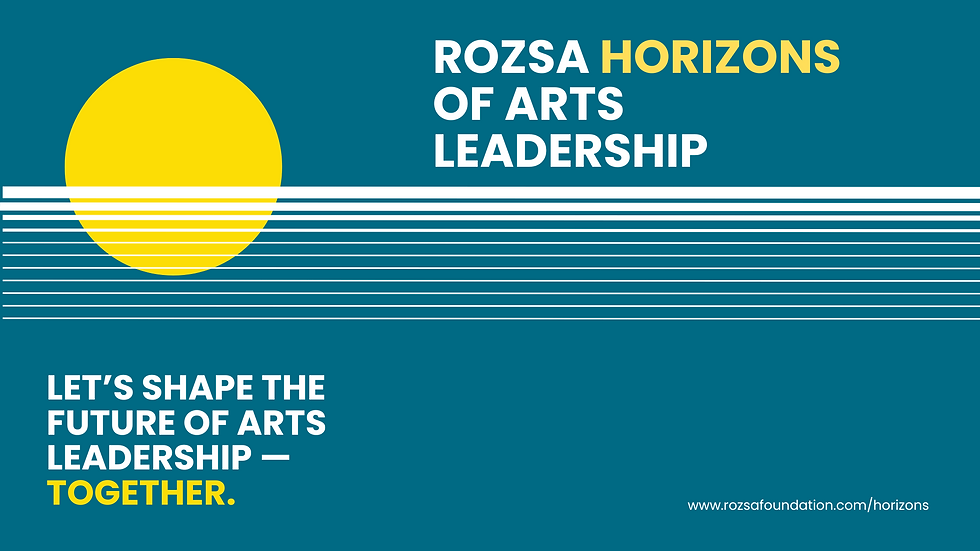iHuman Wellness
- Rozsa Foundation
- Aug 2, 2017
- 4 min read

From September 2015-April 2016 I participated in the inaugural hosting of the Rozsa Arts Management Program (RAMP) held in Edmonton. RAMP is the Rozsa Foundation’s unique certificate program designed for mid to senior level arts professionals and has been offered in Calgary for 6 years and in Edmonton for 1 year. Along with 20 colleagues from 16 Edmonton and area arts organizations, we heard from leading professionals on various topics including human resources, financial management and governance. An important element of RAMP is the self-exploration that participants undertake in a culminating activity known as an Action Learning Project (ALP).
As Executive Director of iHuman Youth Society, our agency isn’t your typical arts-based non-profit. Using harm reduction, strengths-based and trauma informed approaches, iHuman has been supporting traumatized and marginalized youth aged 12-24 years since 1997. This support began when two local Edmonton artists, Sandra Bromley and Wallis Kendal were working on their internationally celebrated art exhibition The Art of Peacemaking: the Gun Sculpture. Street involved youth heard about the project and wanted to participate. Since the project involved decommissioned weapons, the artists offered to guide the youth in mounting their own exhibit. Following months of mentorship, Red Tear opened to rave reviews alongside the Gun Sculpture at the then Edmonton Art Gallery by then Deputy Prime Minister, Anne McLellan, P.C., O.C., A.O.E. When the exhibit closed, it was the youth who petitioned for continued mentorship in creative mediums – hence the birth of iHuman. Since then, we’ve been providing caring, creative and authentic programming in our studio, offering young people opportunities for self-discovery and healing through the arts with a social justice lens.
iHuman’s mission to make a difference in the lives of vulnerable youth is barriered by the significant trauma the young people are present with. Up to 85% of the youth self-identify as Indigenous. With histories of intergenerational trauma, residential schools and colonialism many struggle with addictions, depression, suicidal behaviours and physical illness. Homelessness, children’s services and criminal justice involvement, disenfranchised from school and family, most see little hope for their futures. A feeling of being excluded from society is amplified by experiences of racism, discrimination and criminalization.

In such a work environment, the health and wellbeing of the staff weighs heavy on my mind. I see the staff as first responders on the front lines of distress, listening to accounts of abuse and neglect, de-escalating violence and suicidal behaviours, and counteracting the draw of gang affiliation on a daily basis. The team is comprised of amazing professionals from a Juno-nominated administrator, b-boying social worker, to activist artists and everyday heroes who champion the creative spirit of the youth.
Like many non-profits on tight budgets, we do not have an extensive employee health benefits plan. A nominal annual health spending account, paid sick and bereavement days amount to what we can offer employees. Gratefully, six free counselling sessions annually per employee are provided by a psychologist who donates her time to support staff mental wellbeing.
Given the need, I decided to develop a staff wellness program for my ALP. I researched topics like vicarious trauma, compassion fatigue and burnout – outcomes that affect many individuals in all sorts of professions. Employing strategies learned in RAMP, several assessment tools found on www.compassionfatique.org and counting the number of absent days staff took over the 8 months of RAMP, I found some staggering and surprising results. For one, I’d been short 2.5 staff every day due to sickness, unpaid leave and vacancies during that period! No wonder we were all exhausted. What evolved from this knowledge was an action plan to incorporate additional opportunities to support staff downtime, the implementation of a new lieu day process, a week-long closure this July for a staff retreat and exploring a financial plan for implementing a formal employee benefits plan.
I entered my project thinking I would probably discover much of the staff on the verge of burnout, which given the level of stress factors revealed by the assessments, would have been a logical conclusion. What I was blessed to find, however, was an extremely resilient group that is able to apply the skills they use with the youth in their own coping approaches to themselves and their colleagues. It was also evident, that each employee’s use of creative outlets like painting, playing guitar, dancing and poetry or journaling provided an extra layer of insulating self-care. I’m grateful for the learning and challenge that my RAMP ALP provided me. Without RAMP’s push, I would have continued with the awareness that the staff were heroically treading water and feeling helpless to buoy them up. Now, I have a sustainable and realistic plan which supports the needs of the agency’s precious staff, buffering the inevitable turnover rate experienced in the non-profit sector, and ensures the youth have the staff consistency that is so essential to their own achievements being realized and for iHuman’s mission to be fulfilled.
Catherine Broomfield has been iHuman’s Executive Director since 2010. Among other recognitions, she was recipient of the 2014 Edmonton YWCA’s Woman of Distinction for Advocacy Award and a 2016 short list nominee for The Rozsa Award for Excellence in Arts Management.






Comments